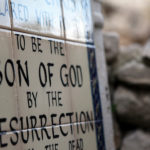We run our website the way we wished the whole internet worked: we provide high quality original content with no ads. We are funded solely by your direct support. Please consider supporting this project.

Jesus Came to Bring a Sword?
Jesus said: “Do not suppose that I have come to bring peace to the earth. I did not come to bring peace, but a sword” (Mt 10:34).
Some, both modern scholars along with church leaders since the fourth century, have used this passage as evidence to argue that Jesus is not altogether non-violent.
When we place Matthew 10:34 in its broader context, it becomes clear that Jesus’ teaching not only does not condone violence on the part of his disciples, it actually rules out all violence. As Jesus is preparing his disciples to proclaim the Good News of the arrival of the kingdom of God throughout the region, he warns them that he is sending them out “like sheep among wolves” (Mt 10:16, cf. vv. 5-15). He tells them they will be “handed over to the local council,” “flogged in synagogues,” and “brought before governors and kings” (vv. 17-18). Moreover, Jesus warns them that their ministry is going to upset the entire social order. “Brother will betray brother to death, and a father his child,” while “children will rebel against their parents and have them put to death” (v. 21). And, Jesus adds, “[y]ou will be hated by everyone because of me” (v. 22). If the master is persecuted and called “Beelzebul,” he says, his servants must expect the same (vv. 21-3). But in all this the disciples are to trust their heavenly Father, even when they face death (vv. 26-31). Jesus then stresses the importance of disciples fearlessly proclaiming the message he has given them, telling them that he will “acknowledge before my Father in heaven” everyone who “acknowledges me before others” (v. 32). On the other hand, Jesus will “disown before my Father in heaven” anyone who “disowns me before others” (v. 33).
It is at this point that Jesus tells his disciples, “I did not come to bring peace, but a sword” (v. 34). When understood in its broader context, it is apparent that Jesus is simply using the image of the sword as a hyperbolic metaphor for the division that the message of the kingdom would bring, which, significantly enough, is how Luke interprets this metaphor (Lk 12:51-2). Jesus is simply telling his disciples not to be surprised or intimidated by the fact that the message of the kingdom is going to cause social upheaval and may even divide the disciples’ own households and result in their martyrdom.
This point is further driven home in the passages that immediately follow this teaching and that clarify its meaning. Jesus first quotes the prophet Micah who spoke of a similar time of social upheaval in Israel. Jesus declares that the message of the kingdom of God will set…
a man against his father,
a daughter against her mother,
a daughter-in-law against her mother-in-law—
a man’s enemies will be the members of his own household (Mt 10:35-6, cf. Micah 7:6).
And then, again driving home the urgency of remaining faithful to Jesus even when being rejected by one’s own family, Jesus tells his disciples that if anyone “loves their father or mother more the me” they are “not worthy of me” (v. 37). So too, he adds, “[w]hoever does not take up their cross and follow me is not worthy of me,” and “[w]hoever finds their life will lose it,” while “whoever loses their life for my sake will find it” (vv. 38-9).
This is the “sword” that Jesus brings to the world. And it is clear that, while this “sword” involves not only division, but violence, none of the violence is carried out by the “sheep” Jesus is sending out. It is rather carried out by “wolves” who engage in violence against the “sheep,” which is precisely why Jesus instructs his disciples to be fearless in the face of death and to take up their cross, as he himself would do in the near future.
In this light, I think it is apparent that those who have appealed to this passage to justify violence throughout history were twisting it to fit their own violent aspirations. And this is confirmed by the fact that it never occurred to anyone to use this passage in this way until the church tragically aligned itself with the power of the State, and thus with the power of the sword, in the fourth and fifth centuries.
Photo credit: h.koppdelaney via Visual Hunt / CC BY-ND
Category: General
Tags: Conflict, Jesus, Non-Violence, Peace
Topics: Enemy-Loving Non-Violence
Verse: Matthew 10
Related Reading

Why Bart Ehrman Doesn’t Have to Ruin Your Christmas (Or Your Faith) Part 2
This is the second of several videos Greg put together to refute Bart Ehrman’s claims published in the article What Do We Really Know About Jesus? If you missed it, you can catch the first installment here.

The Extremity of God’s Love
In response to questions he has received about whether Jesus was actually separated from the Father on the cross, Greg fleshes out his perspective on this. The love that unites the Trinity is the very same love that resulted in the separation of the Father from the Son. This separation actually expresses the great love…

Jesus, the New Israel
The Gospels present Jesus and the Kingdom he inaugurated as the fulfillment of Israel’s story. For example, Jesus’ birth fulfills Israel’s longing for a Messiah; his return from Egypt as a child mirrors their Exodus out of Egypt; his temptations in the desert allude to Israel’s temptations in the desert; his twelve disciples recall the…

Which of the Miracles of Jesus Can Humans Do? (podcast)
Greg is asked about the miracles of Jesus, specifically which miracles do we have the potential to perform. He also gives a nod to the band Theocracy. Episode 74 http://traffic.libsyn.com/askgregboyd/Episode_0074.mp3

Would God Kill a Baby To Teach Parents a Lesson?
Question: We have a group of guys that are going through your book “Is God to Blame” and a question came up that I would be curious how you would look at it. In the beginning of the book you ask the question “do you really think that God kills babies to teach parents a lesson?”…

Religion that Blinds Us to God
For a variety of reasons, many Jews at the time of Jesus had come to believe that heaven had been closed since the writing of the last book of the Old Testament. God was distant and no longer active among his people. Their religion focused on holding fast to the law God had given in…
